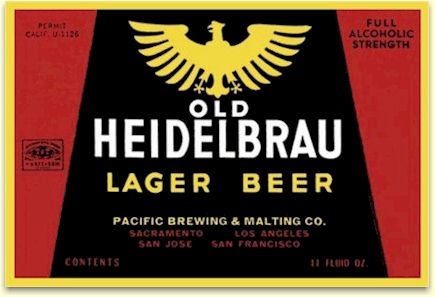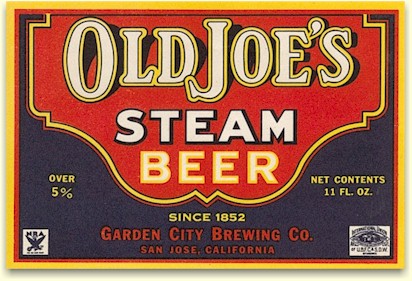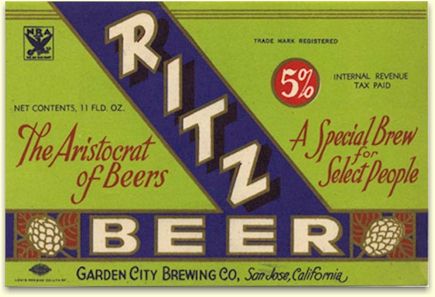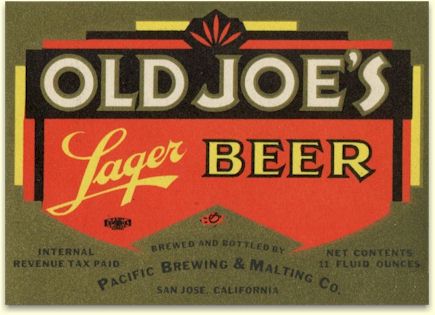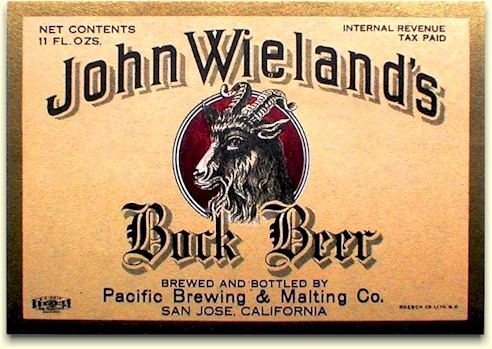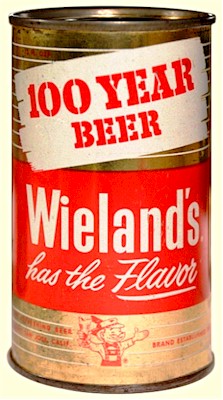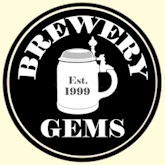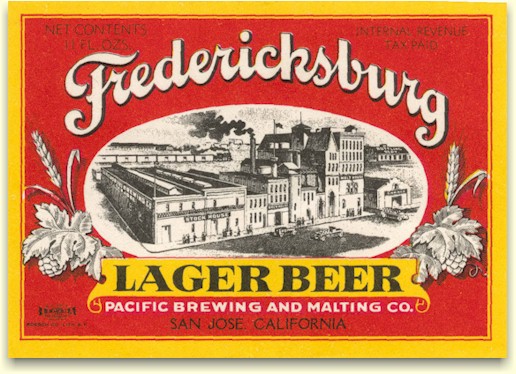
d.b.a. the Fredericksburg Brewing Co.
and
d.b.a. the
Wieland's Brewing Co.
|
While the Pacific Brewing & Malting Co. of San Jose isn't a branch of Tacoma's PB&M, there is a connection.
In 1916,
after being shut-down by Washington's state-wide Prohibition, Huth & Virges of Tacoma's
Pacific Brewing & Malting
built a brewery in San Francisco. It was
located at 675 Treat Ave. and operated under the name Tacoma Brewing &
Malting, but was also doing business as Pacific Brewing & Malting.
Encouraged by positive talks with the Rainier Brewing Co., Colpe
gave the following story to the San Francisco Chronicle
on 18 Feb., 1933:
The new brewery's president wasn't entirely successful in his
negotiations with Rainier. While he had secured use of
the Fredericksburg brand with the purchase of the brewery, he
failed to regain rights to the Tacoma brand. He did,
however, secure Louie Baumgartner as their brewmaster, who had
served as the plant's superintendent prior to Prohibition - the
same as his father before him.
Prior Prohibition there were just three breweries in San Jose,
the Fredericksburg Brewery, the Eagle Brewery, and the Geoffroy
Brothers' Garden City Brewery. All three Breweries ceased operations
in 1918 due to WW1 conservation restrictions. During the years
of Prohibition (1920-1933) many breweries continued operating by
producing near-beer or soft drinks, but the San Jose plants
remained shuttered until Repeal in 1933.
Pacific Brewing &
Malting's Fredericks Brewery was ready with
product the day legal beer was permitted. Fredericksburg Beer
hadn't been forgotten and it was immediately in high demand. They
also released Old Heidelbrau at the same time, and it too, did
well initially. While officially the Pacific Brewing & Malting
Co. they were also doing business as the Fredericksburg Brewing
Co. - at least until about 1941.
In order to maximize plant capacity many breweries leased
portions of their plants or contracted to brew and bottle for
for other companies. Pacific Brewing & Malting (PB&M) chose the later, and produced
Franco's Quality Lager for a local market chain. Later they also
produced the budget supermarket beer, Brown Derby.
In November of 1934 PB&M introduced the Cortez brand of
beer, perhaps to attract more Latino customers. It was first
available as Cortez Draft in half-gallon bottles. They later
shifted to Cortez Beer in a 22 oz. bottle, discontinuing Draft
in a jug.
Initially,
Pacific Brewing & Malting's local competition consisted
of only the Garden City Brewery, since the Eagle Brewery had
been dismantled for its bricks in the mid-1920s. However, the
Geoffroy Brothers (George & August) were having trouble finding
enough financing to re-start their plant. So they reorganized
Garden City Brewing as a distributing company and
contracted for the brewing and bottling of their brands.
Garden City Brewing Co.
The Geoffroy Brothers chose two brands for the roll out upon
Repeal, one of which had a long history in San Jose. Old Joe's
Steam beer was a brand of the now defunct Eagle Brewery. It was named after the brewery's founder,
Joseph Hartmann, who established the brewery about 1852. Old Joe's
Steam beer was still being sold up until 1918, and was well
remembered.
The Geoffroy Bros.
put the 1852 date on the label to tout the brands iconic status
in San Jose.
The other brand
they chose was Ritz Beer, which seems to have originated with
the Brothers. Both of these beers were brewed & bottled in the
Fredericksburg Brewery.
Garden City also distributed Old Joe's
Lager beer, and Ritz
Steam beer.
After a few years of contract brewing the Geoffroy Brothers
merged their business with PB&M, becoming major stockholders in
the Fredericksburg Brewery. Both of the brothers would serve on the
company's Board of Directors, and August Geoffroy would serve as
the brewery's vice-president. With the merger, the Garden City
brands were transferred to PB&M. The Old Joe and Ritz
brands were then marketed with PB&M labels.
In the late '30s PB&M added an ale to their line-up. Their first
offering was Boilermaker Ale and Pale Ale, a brand that was marketed to the
working class, like factory workers, union men, and "manly" men
in general. They later modified one of their existing brands to attract a different
demographic, specifically women. Ritz Beer was offered in an 8 oz.
bottle with a label that reflected elegance and refinement.
The Ritz Beer label, ca.1939, is
noteworthy in that it states "brewed by Wielands." This would
suggest a new direction for the brewery.
Wieland's Brewing
Co.
(1939-1952)
In July of 1936 Pacific Brewing & Malting
purchased an historic San Francisco brand, famous for
eighty-four years. The plans to reopen the old John Wieland Brewery had been abandoned
after a failed stock offering, which presented PB&M with the
opportunity to purchase the iconic brand.
Wieland's Extra Pale was introduced to the
public in September of 1936. While available in bottles and on
draft, the brand became their first, and only, canned beer. It
was introduced in a cone top style can. In addition to their Extra Pale Lager they produced a
Bock Beer, and later added a Cream Ale, which replaced their
Boilermaker Ale.
By Oct. of '41,
sales of Wieland's Lager had out paced
Frederickesburg Beer and the brand was dropped, along with the Old
Joe's and Ritz brands. With the outbreak of WWII, war-time
restrictions prohibited canning beer, except for the Armed
Forces. It wouldn't be until 1947 that canned beer was back on
the market, and when it was, Wieland's Extra Pale Lager appeared
in a flat top can.
In 1947 the brewery's annual output was a high of 198,000 barrels.
However, competition from larger San Francisco breweries and
inroads by eastern brewers was taking its toll on PB&M. By 1951
they were down to 120,000 barrels.
In March
of 1952, Pacific Brewing & Malting made a name change and
officially became the Wieland's Brewing Co.
Then two months later, on May 13th, the company introduced their "100 Year
Beer" - erroneously claiming that the brand was created in 1852.
Actually, John Wieland established his Philadelphia Brewery in San
Francisco, in 1855,
not that anyone really cared. Perhaps the company recalled placing
"1852" on the Old Joe's Steam Beer label.
Ultimately, the Wieland's Brewing Company was to be a short
lived venture. In November of '52, after a mere eight months and
a continued decline in sales, it was announced
that the brewery had been
purchased by the Griesedieck
family of St. Louis, making it their western branch of the Falstaff
Brewing Corp.
The same fate was to befall two other breweries in decline. In
July of 1953 the Rainier Brewing Co.
was purchased
by the Theo. Hamm Brewing Co. of MN; and in
January of 1954 the Acme Brewing Co. was
taken over by
Liebmann Breweries of NY.
Only the strong survive.
Article by
Reverse painted on glass sign, ca.
1939
ACKNOWLEDGEMENTS
For any comments, additions, or corrections -
All contents including images are copyright by BreweryGems.com |


